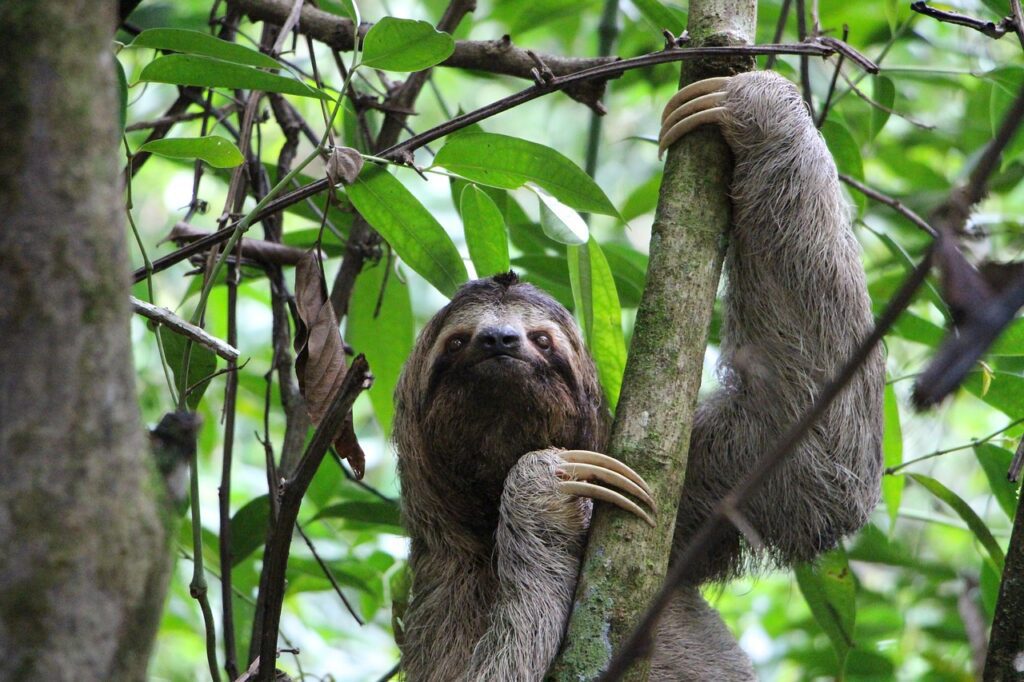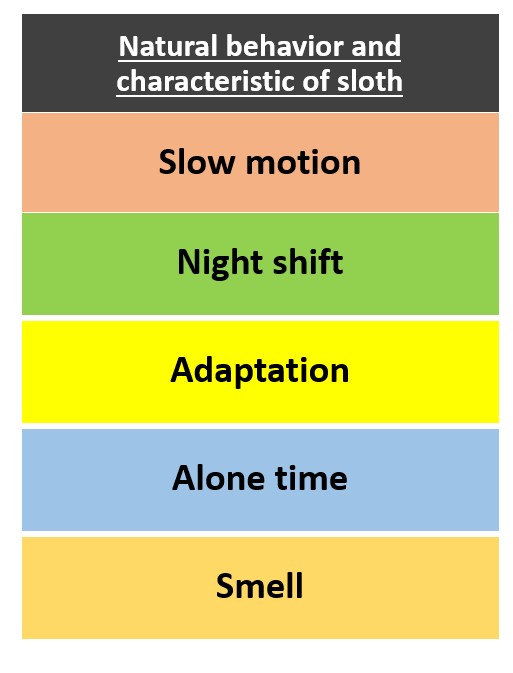
Image Credit: Pixabay
To gain a comprehensive understanding of sloths, delve into the introduction of this article. With a focus on the definition of sloths and background information, as well as an overview of public perception, you’ll gain valuable insights into these intriguing creatures.
Key Takeaways
- Sloths are generally not dangerous to humans. They have a slow and docile nature, and their main defense mechanism is to remain motionless or retreat when threatened.
- While sloths have long claws, they are not typically used for aggression towards humans. Instead, they are adapted for climbing and hanging from trees.
- It is important to respect sloths’ natural habitat and not disturb or provoke them. Approaching a sloth too closely or attempting to touch or handle them can cause stress and potentially harm the animal.
- Sloths may carry certain parasites or bacteria, but the risk of transmission to humans is low. It is still advisable to avoid direct contact with wild sloths to minimize any potential health risks.
- In some rare cases, sloths may bite or scratch if they feel threatened or cornered. However, these instances are extremely uncommon and can usually be avoided by giving the animal space and not provoking it.
- Overall, sloths are fascinating and unique creatures that play an important role in their ecosystems. By understanding their behavior and respecting their natural habitat, humans can coexist with sloths safely and enjoy observing them in the wild.
Definition of Sloths and Background Information
Sloths are a fascinating species, known for their slow movement and relaxed attitude. They live in the forests of Central and South America and are part of the order Pilosa, which is divided into two families: Bradypodidae (three-toed sloths) and Megalonychidae (two-toed sloths). Even though they have three toes, each family has different features.
These creatures mainly eat leaves, buds, and shoots, which don’t provide them with much energy. It’s because of this that they need to conserve energy in order to survive, resulting in their famously slow movements and tendency to sleep a lot.
To help protect these amazing creatures, we can do the following:
- Preserve their natural habitat as deforestation is a major concern.
- Raise awareness about the importance of a balanced ecosystem.
- Promote sustainable tourism practices to protect habitats and educate visitors.
- Encourage scientific research and fund initiatives to understand sloth behaviors.
By following these suggestions, we can ensure future generations can appreciate these incredible animals. Let’s all work together to create a better future where we appreciate nature’s diversity and protect our planet for all its inhabitants.
Overview of Public Perception of Sloths

Sloths have become a source of curiosity for the world. Here’s what the public thinks about them:
- Sloths are seen as slow and relaxed.
- They’re often linked to laziness.
- People think they are cute and adorable.
- Many believe sloths hang upside down from trees, showing their strength.
- They are assumed to be harmless.
- Their claws and facial markings add to their intrigue.
Not many people know that sloths play an important role in their ecosystems. Their slow movements and special digestive system help spread seeds and regrow forests.
Arguments for Sloths Being Dangerous

To better understand the potential dangers of sloths, explore the arguments for sloths being dangerous. Discover the potential risks and threats associated with sloths, as well as real-life examples of incidents involving these slow-moving creatures.
Potential Risks and Threats Associated with Sloths
Sloths may appear harmless and docile, but they can be dangerous! Their sharp claws, slow reflexes, and camouflaging abilities all pose potential risks.
Their claws can cause serious harm if provoked. Plus, their sluggish movements make them susceptible to parasites and bacteria which can transmit diseases to humans and other animals.
On top of that, sloths’ tree-dwelling nature and camouflaging abilities can be a hazard when humans or animals come too close without being aware.
So, take some time to appreciate a sloth’s beauty but also stay informed about the risks they pose. Be aware of their true nature and don’t be fooled by their slow-motion crawl – these fluffy ninjas could be lurking in the treetops!
Examples of Incidents Involving Sloths
Sloths, often thought of as harmless, can surprise with unexpected behavior. Incidents like attacking tourists, displaying aggression towards caretakers, and falling from trees have highlighted their potential danger.
It’s important to respect their boundaries. Even though not common, sloths can be risky if provoked or approached without caution.
Pro Tip: When you see sloths, keep your distance and observe without interfering. This ensures your safety and theirs.
Counterarguments against Sloths Being Dangerous
To further understand the reasons why sloths are not dangerous, explore the counterarguments against this perception. Discover the natural behavior and characteristics of sloths, as well as expert opinions and research on sloth behavior.
Natural Behavior and Characteristics of Sloths

Sloths are amazing creatures, known for their laid-back pace. They have traits that make them unlike any other animal! Here’s a look at some of the intriguing facts about sloths.
- Slow-motion: Sloths move at a relaxed speed. This helps them save energy as they climb through trees.
- Night shift: Sloths are mainly active at night. This is thought to protect them from predators and take advantage of cooler temperatures.
- Adaptations: Sloths are adapted to life in trees. Their long claws help grip branches. Special pellets make it easier to digest foliage.
- Alone time: Sloths are mostly solitary. They only interact with others during mating season.
- Smell-o-vision: Male sloths scent-mark their territory. This lets them communicate and set boundaries without physical confrontation.
Plus, sloths have fur that houses symbiotic algae. This provides camouflage and nutrients.
Sloths have an extremely low metabolic rate. This helps them save energy, even on a plant-based diet.
These details show why sloths should be celebrated – not feared. After all, they’re as dangerous as a feather duster!
Expert Opinions and Research on Sloth Behavior
Experts’ opinions and research on sloth behavior show us fascinating facts about these unique creatures. We can gain deeper knowledge of the realities behind the common misconceptions about sloths.
The table below gives an overview of expert opinions and research findings about sloth behavior:
| Expert Opinions and Research on Sloth Behavior |
|---|
| Sloths have slow metabolism. |
| Sloths hang upside down most of the time. |
| Sloths are usually herbivores. |
| Sloths have special adaptations for their arboreal life. |
Research also highlights other interesting aspects of sloth behavior. For example, studies show that some sloths stay still for long to save energy. Some even grow algae on their fur to blend in better with their environment.
When we talk about sloth behavior, it’s important to keep in mind certain suggestions:
- Remembering their slow metabolism means they are not dangerous predators.
- Acknowledging their special adaptations helps debunk any misconceptions about their supposed aggression.
By understanding and respecting sloths for who they are, we can recognize their charm and their perfect adaptation to their environment. By sharing correct info about sloth behavior, we can ensure that these amazing animals get the appreciation they deserve.
Frequently Asked Questions
Q: Are sloths dangerous?
A: Sloths are generally not dangerous to humans. They have a very slow metabolism and move sluggishly, making them unlikely to attack. They have long claws, but they use them for climbing rather than for self-defense.
Q: Can sloths harm you in any way?
A: While sloths are not aggressive, they may defend themselves if they feel threatened. Their long claws can cause scratches, and their bite can be painful due to their sharp teeth. However, such instances are rare.
Q: Do sloths carry diseases?
A: There is a possibility of sloths carrying diseases, just like any other animal. However, the risk of contracting a disease from a sloth is extremely low. It is important to avoid direct contact and respect their natural habitat to minimize any potential risk.
Q: Can sloths attack humans?
A: Sloths do not usually attack humans. They are peaceful creatures that prefer to retreat or camouflage themselves rather than confront threats. However, if provoked or cornered, they may defend themselves, but serious attacks are extremely rare.
Q: Are baby sloths dangerous?
A: Baby sloths are not dangerous. They rely on their mothers for survival and are more vulnerable than adult sloths. They are known for their adorable nature and are generally harmless as long as they are not mishandled or threatened.
Q: How should I behave around sloths to stay safe?
A: To stay safe around sloths, it is important to respect their space and observe them from a safe distance. Avoid trying to touch or handle them, as it can cause stress and potentially harm the sloth. Enjoy their presence from a respectful distance and let them continue their natural behaviors undisturbed.
Conclusion
To sum up the discussion on sloth danger, here’s a brief conclusion. You’ll find a summary of the arguments and counterarguments presented earlier, followed by my personal opinion and final thoughts on the topic. Recommendations work by addressing challenges and pushing us towards a more comprehensive approach. All suggestions aim for a holistic solution.

